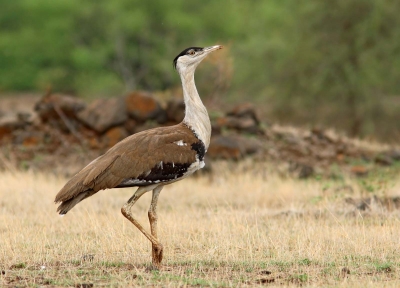
The great Indian bustard was once seen across the grasslands of India and Pakistan. Today though, the situation is worrying. They are found only in small and isolated fragments of their remaining habitats. They are said to have disappeared from about 90% of their original habitats, and are now confined mostly to Rajasthan. One of the best places to spot the bird in the wild is the Desert National Park (DNP) in Rajasthan. Spanning over 3,000 sq. km., it is spread across Jaisalmer and Barmer districts. Forming a part of the great Thar Desert, this Park is said to have at least 100 of these bustards. Sadly though, there are no recent confirmed sightings of these birds in places such as Maharashtra and Karnataka where they were spotted earlier.
Threats
Traditionally, the dramatic loss in the number of birds has been due to large-scale hunting – for meat and sport. What added to the problem was systematic habitat loss and degradation. Turning their grassland habitats into agricultural land has dealt them a double blow – loss of food and closer contact with humans and cattle. Further, stray animals such as dogs too entre these habitats and destroy the eggs of these birds. However, one of the major dangers that these birds faces today is the power lines. As heavy, low-flying birds, the chance of their coming into contact with powerlines and even wind turbines is high. Many meet their end thus. Infrastructure development and ill-informed habitat management too add to their problem. And, the species is facing the threat of extinction.
Something to cheer about
Thanks to a move by the Convention on Migratory Species in February 2020, the great Indian bustard was added to Appendix I: the strictest level of protection. And something just as positive has been happening even before this move, according to a media report. Over three years ago, a project involved the local community around DNP for great Indian bustard conservation. As part of the project, a group of young people was chosen to be nature guides, who would inform conservationists about the presence of the birds in their area. They would also keep the forest department updated about the movement of poachers in the region. This continuing project has not only supported the young people monetarily, it also helped them understand the need to protect the bird and its habitat. It has additionally programme and habitat protection, this project could go a long way in bringing hope for the survival of the species.
The great Indian bustard facts
- The great Indian bustard is a large, white-and-brown bird with wing marking and a black crown.
- These birds usually inhabit dry or semi-arid grasslands marked by scrub, bushes, sparse vegetation, minimal cultivation, and rich in insect and crop resources.
- They are said to be deeply connected to the habitats they use, and so keep returning to these places. However, when they realize the place is disturbed or has become unsuitable for them, they abandon it.
- The species has been categorized as “Critically Endangered” on the International Union for Conservation of Nature’s list because of its low numbers.






